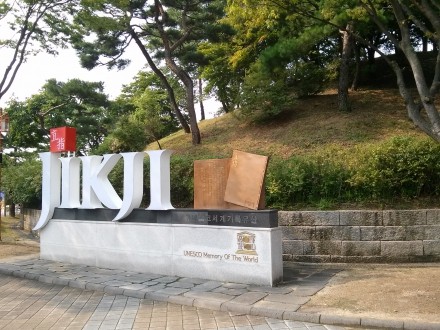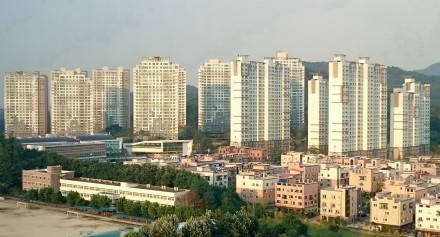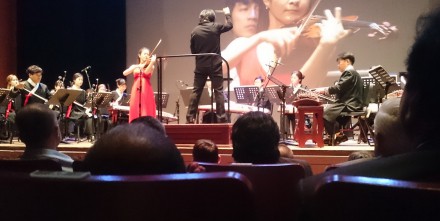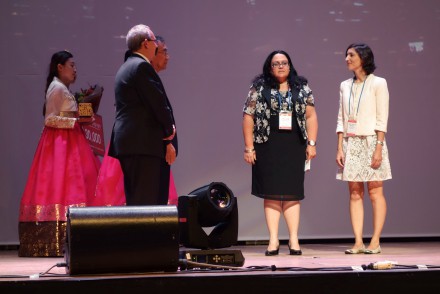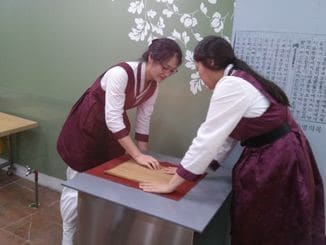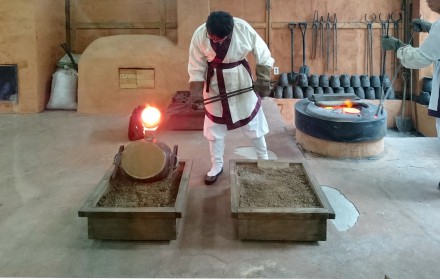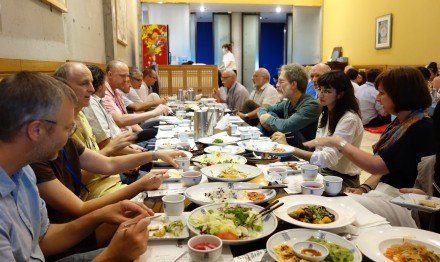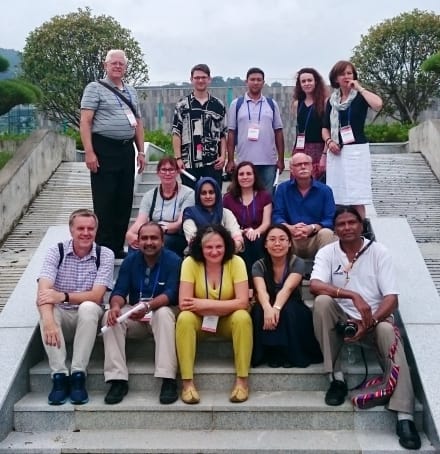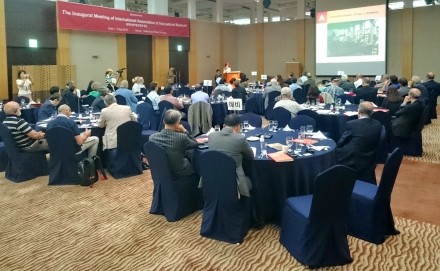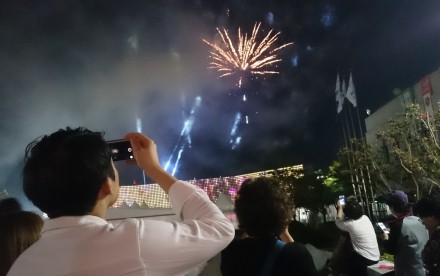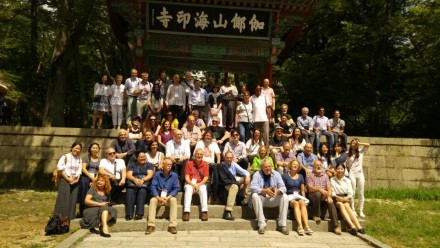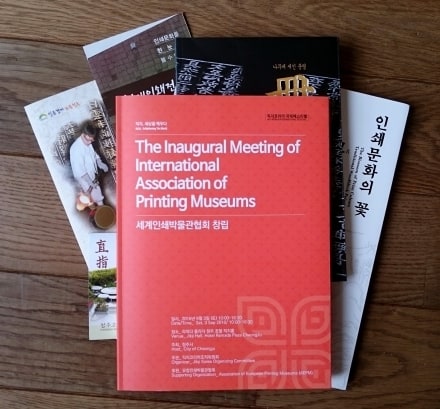The AEPM at the Jikji International Festival: an unforgettable experience!
Thirty members of the AEPM made the trip to South Korea to take part in the inaugural meeting of the future International Association of Printing Museums which was held in Cheongju City on the 3 September 2016.
The following account, by Sheza Moledina (Lyon, France), gives the flavour of five unforgettable days.Get a taste of the places, the people and the atmosphere in the AEPM Flickr photo album here.
Since 2004, the Jikji Korea festival – a loose grouping of festive, artistic and cultural events – has been organised each year by the City of Cheongju in South Korea, 128 km to the south-east of Seoul in the province of Chungcheongbuk-do. This year, with the support of the Korean government, it changed dimension to become the Jikji International Festival. Cheongju is home to the Early Printing Museum which was established in 1992 on the site of the Heungdeoksaji Temple where the famous Jikji was printed. For those who may not already be aware, the Jikji is the oldest known book printed using moveable metal type. It entered the collections of the French national library (Bibliothèque nationale de France) in the 1950s. The Early Printing Museum is entirely devoted to the history of Korean printing during the Goryeo and Joseon dynasties and, especially, the history of the Jikji, a document of inestimable historical value which was included in Unesco’s Memory of the World programme in 2001.
Dated 1377, the Jijki (the abreviated title of the work which means several things including ‘govern directly’ or encore ‘healthy spirit’) is a Korean language anthology of the zen teachings of Buddha and the buddhist high priests, printed in Chinese characters. It has a quasi sacred value for Koreans, not only because of its religious content, but also because it bears witness to the country’s considerable technical achievements in the field of printing well before Gutenberg’s invention of typographical printing in Mainz; and the products of his press of which the most illustrious is the 42-line Bible. Given the importance which is attached to the invention of moveable type in the West – considered to be at the origin of a veritable ‘media revolution’ – it is easy to understand why such importance is accorded to the Jikji which, in spite of its apparently sobre appearance, has become a source of national pride for South Korea, a country which is relatively little known to Europeans but which is culturally extremely rich.
The representatives of the AEPM made up about half of the 60-odd delegates which had come from all over the world at the invitation of the City of Cheongju to take part both in the Jikji International Festival and in the inaugural meeting of the International Association of Printing Museums. The following is a taste of what was an intense and extremely enriching visit from the 31 August till the 5 September 2016.
Wednesday 31 August: arrival at Cheongju
On our arrival at Incheon Airport (Seoul) we were warmly welcomed by Mr Jewook Lee, the coordinator of the organising committee of the Jijki International Festival and his two assistants. An hour later we were on our way by coach to Cheongju, where the festival was to open the following day. After our flight from Europe, the voyage seemed long and our first impressions were somewhat fuzzy, partly because of the intermittent rain which accompanied us, partly because of the jetlag! But, two and a half hours later, in the early afternoon, we reached Cheongju coach station where we were welcomed by another coordinator of the Festival team who took us by taxi to our final destination, the imposing Ramada Plaza Hotel with its spectacular view over the rapidly expanding city of Cheongju.
At seven o’clock sharp, after a few hours rest (for some of us at least) to avoid the worst of our jetlag, a small group of delegates met up in the foyer of the hotel to become acquainted. It was quickly decided to set off to discover Korean cuisine.
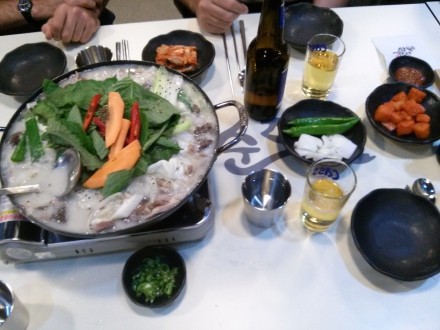 Our choice settled on a small restaurant close to the hotel which looked somewhat like a canteen, but with a touch of Korean design and irreproachably clean. The menu was exclusively Korean, the waiter spoke only a few words of English but was charming and keen to find a way to communicate with us, and so we chose to go in at the deep end with a choice of straight Korean! Our chosen dish was a fondue made up of tripe, vegetables and sausages (sundae) served with the redoubtable but omnipresent kimchi and other spicy fermented vegetables accompanied by a selection of beautiful looking hot green peppers (taste them if you dare!). The flavours were disconcerting for our delicate European palates, but well worth tasting at least once in your life.
Our choice settled on a small restaurant close to the hotel which looked somewhat like a canteen, but with a touch of Korean design and irreproachably clean. The menu was exclusively Korean, the waiter spoke only a few words of English but was charming and keen to find a way to communicate with us, and so we chose to go in at the deep end with a choice of straight Korean! Our chosen dish was a fondue made up of tripe, vegetables and sausages (sundae) served with the redoubtable but omnipresent kimchi and other spicy fermented vegetables accompanied by a selection of beautiful looking hot green peppers (taste them if you dare!). The flavours were disconcerting for our delicate European palates, but well worth tasting at least once in your life.
Thursday 1 September: visit to the Early Printing Museum and inauguration of the Jikji International Festival
The week was going to be very busy and some of us had not yet adapted to our new time zone. But we all made the best of it in order to do justice to the extremely interesting programme which our hosts had prepared for us.
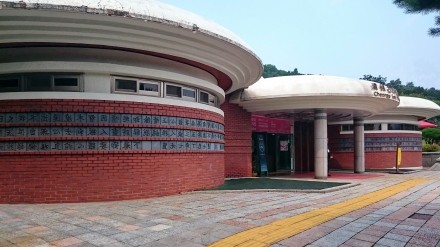
Early Printing Museum. A photo album devoted to the Museum can be found in the AEPM’s Flickr gallery at: https://www.flickr.com/photos/printing-museums/albums/72157673680708666.
After a copious breakfast we went by coach to the Early Printing Museum for a guided tour accompanied by the director Heung-Sik Shin and our guide for the morning, the head curator Dr Jeong-Ha Hwang. Built on the site of the Heungdeoksaji Temple, the Museum is devoted to the history of the Jijki and the various printing techniques used by the Goryeo and Joseon dynasties: production of moveable wood and metal type, typefounding using sand casting and the lost wax method, wood cutting, etc. In the Museum’s shop, the amateurs of printing and paper among us were able to stock up on hand made paper and impressions taken from Korean wood blocks.
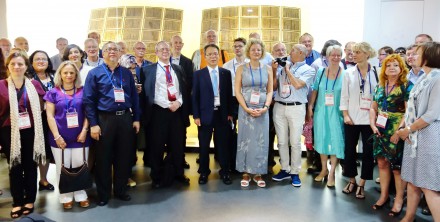
Our guide, the head curator Dr Jeong-Ha Hwang, with the delegates in front of a complete set facsimiles of the pages of the Jikji.
The visit was followed by a delicious lunch at a gastronomic Chinese-Korean restaurant with our colleagues from the Early Printing Museum.
After lunch we returned to the Jikji International Festival for the official opening in the auditorium of the Arts Center. Two high points of the inauguration ceremony, which took place in the presence of the City Councillors, were the performance by an orchestra of traditional Korean musicians which opened the proceedings, and the award of the Unesco/Jikji Memory of the World prize for 2016 by Frank La Rue, vice-general director of Unesco for communication and information, to Iberarchivos, a programme aimed at the development of Ibero-American archives (ADAI).
We were then free to visit the Festival with its principal exhibition « Jikji, The Golden Seed », its numerous arts and crafts stands scattered around the site, the Craft Museum, the Museum of modern printing in Korea (with its typefounding and casting machines, etc.) and also… and this is going to make you regret not having come on the trip… two fascinating demonstrations of type casting in sand and Korean hand paper-making using formes made with bamboo.
Seeing how these techniques were carried out in practice is virtually impossible in Europe. So the demonstrations offered us a rare occasion to fully understand the complexites of these ancient processes, especially the casting of Chinese and Korean (in the Hangeul script) moveable type.
And so to dinner at the hotel with the Mayor of Cheongju, Frank La Rue and representatives of all the organisations which had received the Jijki Memoire of the World prize since its inception six years ago.
Friday 2 September : visits and discoveries
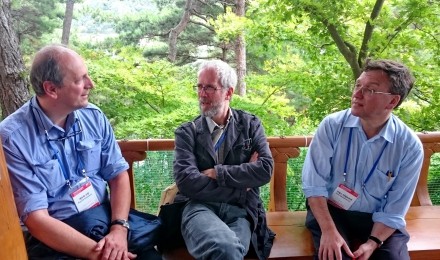
Patrick Goossens, Neil Harris and Giles Mandelbrote in conversation in the grounds of the Presidential Villa.
The morning was taken up by a visit to the Presidential Villa, Cheongnamdae. Built in 1983, this vast mansion beside Lake Daecheong-ho was the summer home of several presidents of the Korean Republic up until about 2000. Since 2003 the residence and its extensive grounds have been opened to the public. For the AEPM delegates it was an occasion to discover this idyllic landscape with its view of the lake and the surrounding mountains, and to stroll along the tranquil paths which run through the surrounding woods.
This moment of relaxation and discussion was followed by lunch in a traditional Korean restaurant in which shoes are left at the entrance and one eats cross-legged on cushions at low tables. For the Europeans such an unaccustomed (some might say uncomfortable) position for eating was largely compensated by the quality and refinement of the dishes which were without exception, and without exageration, all absolutely delicious. A veritable delight!
We then visited the Presidential Archives in Seongnam. The archival collections are preserved in an impressive, brand new building which includes a museum dedicated to the promotion and glorification of the South Korean presidential regime. The didactic and imposing permanent exhibition recounts the history of the successive presidents of the Republic and the role of the Archives.
In the evening we dined with the deputy Mayor of Cheongju at a gastronomic Korean restaurant. As ever, the many dishes were as delicious and varied as they were inhabitual. Many were hot and spicy, by our European standards, but with new each meal we were discovering a different facette of Korean cuisine.
Saturday 3 September : inaugural meeting of the International Association of Printing Museums
The day was entirely given over to the inaugural meeting of the future International Association of Printing Museums under the aegis of the representatives of the City of Cheongju, the organising committee and colleagues from the Early Printing Museum. A large part of the programme was made up of presentations by colleagues from different parts of the world: curators of museums of printing and the graphic arts, or of specialised documentary and archival collections, as well as other specialists working in the field of printing heritage.
The presentations underlined the diversity of organisations and institutions involved and the difficulties which they face in their efforts to preserve, study and make known such a wide range of heritage materials (documents, artefacts, machines, skills, architecture). They also reinforced among all those present just how rare and precious typographical skills are and how difficult they are to pass on to future generations, while at the same time highlighting the many questions facing researchers working on the history of printing and graphic communication.
The day finished with a discussion of the proposed statutes of the International Association of Printing Museums. Numerous points were raised concerning the preparatory document which had been circulated and the aims of the future association. Several delegates emphasized the importance of bringing together not only organisations but also individuals (pratical printers, researchers and other specialists involved with graphic heritage materials), as well as the need to extend contacts with colleagues in Asia, North and South America, Africa, the Middle East, Eastern Europe and Russia in order to make the network truly international. The discussion clarified the aims of the future association and the principal questions to be addressed in order to get this important and legitimate project off the ground.
It was decided to set up a working group to clarify the aims of the association, to finalise the details of the statutes, and to involve as many potential members of the network as possible in the preparatory work with a view to founding the new Association at a meeting to be held in two years time.
In the evening, after the meeting, the delegates were invited to an informal “Friends’ party” on the Festival site along with the artists and Jikji Prize winners with the added attraction of an excellent local beer (Magpie) and a magnificent fireworks display to add a particularly festive note to the proceedings.
Sunday 4 September: visit to the Haeinsa Temple
A nine o’clock start for a visit to the Haeinsa Temple on the slopes of Mount Gaya, in the heart of the magnificent Gayasan national parc (in the province of Gyeongsangnam-do) two and half hours from Cheongju. After lunch in an excellent nearby Korean restaurant where we were treated to another extended selection of local specialities, we arrived at the Temple. Built in the 15th century, the Haeinsa Temple houses the famous and infinitely precious Tripitaka Koreana dating from the 13th century, the most exhaustive collection of Buddhist texts in the form of the 80 000 woodcuts used to print them.
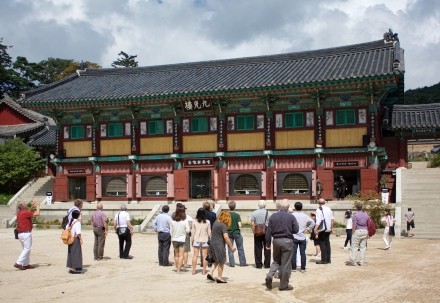
Delegates arriving at the Haeinsa Temple which houses the wood blocks used to print the Tripitaka Koreana.
The wood blocks of the Tripitaka Koreana are also Unesco World heritage. Because of their value and fragility, they require very particular conditions for their conservation and security. So it wasn’t altogether surprising that they are not readily available or visible for the general public. As a small consolation it was, however, possible to obtain an impression on hand-made paper of one of the famous texts for a mere 5,000 WON (4 euros). And the site itself is absolutely magnificent and well worth the visit. One can’t but be affected by the beauty of the surrounding countryside and the gentleness which permeates the site of the Temple which lends itself perfectly to meditation and calm. Apparently it is also possible to visit the site at leisure thanks to the « templestay » programme.
The day continued with a visit to the Hapcheon cultural complex, inaugurated en 2011 on the occasion of the festival marking the millenium of the Tripitaka Koreana. It is devoted entirely to making this national treasure known to as broad a public as possible through cultural activites, performances, workshops, exhibitions and demonstrations.
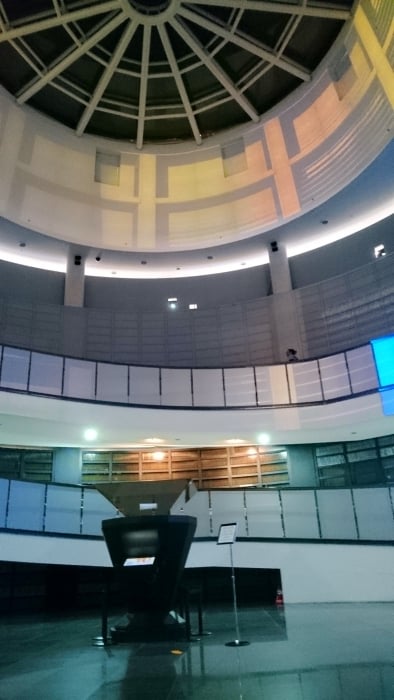 The main building is made up of several exhibition halls, the largest of which houses a didactic presentation with animated figures (monks, scribes, engravers, paper makers, etc.), similar to those in the Early Printing Museum, which retrace the different stages in the making of the Tripitaka wood blocks, from the preparation of the wood through the inscription of the texts onto strips of paper, their engraving and printing by rubbing, to their assembly as a roll of printed paper.
The main building is made up of several exhibition halls, the largest of which houses a didactic presentation with animated figures (monks, scribes, engravers, paper makers, etc.), similar to those in the Early Printing Museum, which retrace the different stages in the making of the Tripitaka wood blocks, from the preparation of the wood through the inscription of the texts onto strips of paper, their engraving and printing by rubbing, to their assembly as a roll of printed paper.
The spectacular central spiral staircase is decorated with facsimiles of the 80,000 wood blocks intended as a means of transmitting the precious knowledge they contain to future generations in the event that something should happen to the originals. Towards the end of the visit each of us had the opportunity to try the rubbing technique to print from a metal facsimile of a wood block a copy of a Buddhist sutra which we could take away.
Upon our return to Cheongju we dined at the hotel and began to say our adieux, with final exchanges of visiting cards, email addresses and other information to help us keep in touch. Not to mention photos… The ambiance was warm but not without a certain tristesse, and we all sincerely hope that the adventure is only beginning and that our visit will bear fruit in the very short term.
Monday 5 September: ce n’est qu’un au revoir…
It’s time to leave Cheongju, each of us flying off to the part of the globe we came from. Many of us went straight home, others stayed on for a few days to visit Seoul, to visit more museums, to go shopping, to continue their culinary explorations, or simply to prolong the pleasures of the change of scenery. Some set off to explore the natural landmarks of the country.
Thee trip was a wonderful experience, enriching from all points of view: the possibility of creating a world-wide network which will allow museums of printing and graphic communication to exchange and share their knowledge and experience; stimulating encounters with all sorts of people, from all walks of life, committed to printing heritage, and the discovery of a country of many contrasts in which traditions are deep rooted and constantly present, but seem to coexist with “modernity” and the latest technolgies; and, of course, our encounter with Korean people whose charm, and constant consideration are rivalled only by their generosity and hospitality. We can only bow before their erudition and determination to promote and defend their cultural heritage, the Jikji in particular.
Our heartfelt thanks to the city of Cheongju, to the committee of the Jikji International Festival and to the AEPM for all the effort and determination they put into making the visit and the meeting possible. Let us hope that the initiative will have the results we all hope for and will lead to other encounters equally necessary and enriching.
Sheza Moledina
independant researcher in book and library history
Lyon, France
Early Printing Museum photo album in the AEPM’s Flickr gallery
Inaugural meeting of the International Association of Printing Museums
Saturday 3 September 2016
Cheongju, South Korea
List of participants
Mark Barbour, director, The International Printing Museum, California, United-States
Robin Boone, coordinator printing section, MIAT, Ghent, Belgium
Robert Clerebaut, board member, Association of European Printing Museums (AEPM), Brussels, Belgium
Bernhard Dorn, Drucken-und-Lernen Foundation, Germany
Andreas Düspohl, director, Internationales Zeitungmuseum, Aachen, Germany
Martha Ferriol, director, Iberarchivos-Programa ADAI, Cuba
Pascal Fulacher, director, Atelier du livre d’art et de l’estampe, Paris, France
Prof. Dr. Amareswar Galla, executive director, The International Institute for the Inclusive Museum, Australia / India
Dr. Sundar Ganesan, director, Roja Muthiah Research Library, Chennai, India
Berta García del Real Marco, coordinator, Iberarchivos-Programa ADAI, Spain
Patrick Goossens, collector of historic printing machines, Antwerp, Belgium
Thomas Gravemaker, LetterpressAmsterdam, Amsterdam, Netherlands
Dr. Eva-Maria Hanebutt-Benz, writer, Germany
Neil Harris, professor of bibliography, University of Udine, Italy
Robert Hartman, Gutenberg-Museum Mainz, Germany
Mr. Robert Heather, director, New England Regional Art Museum (NERAM), Australia
Marijke Hellemans, curator, Plantin-Moretus Museum, Antwerp, Belgium
Hiroko Hisano, secretary, Printing Museum, Tokyo, Japan
Ya-Wen Ho, Wai-Te-Ata Press, New Zealand
Alain Hurstel, director, Espace Gutenberg, Straßburg, France
Jeong-Ha Hwang, head curator, Early Printing Museum, Cheongju, South Korea
Chin Im, Frankfurt, Germany
Koichi Kabayama, director, Printing Museum, Tokyo, Japan
Mine Kuçuk, consultant, Istanbul Museum of Graphic Arts (IMOGA), Istanbul, Turkey
Prof. Indra Kupferschrift, professor, HBKSaar, University of Arts, Germany
John A. Lane, historian, typographer, Netherlands
Seung Lee, curator, Early Printing Museum, Cheongju, South Korea
Dr. Annette Ludwig, director, Gutenberg-Museum, Mainz, Germany
Noriko Maehara, curator, Printing Museum, Tokyo, Japan
Mr. Uma Maheshwar Rao Golla, executive engineer, Department of Archeology and Museum, Andhra Pradesh Government, India
Giles Mandelbrote, librarian and archivist, Lambeth Palace Library / Printing Historical Society, United Kingdom
Dr. Ahmed Mansour, deputy director, The Bulaq Press, Cairo, Egypt
Alan Marshall, President, Association of European Printing Museums (AEPM), France
Dr. Sheza Moledina, independent scholar, Lyon, France
Izumi Munemura, head of creation & planning, Printing Museum, Tokyo, Japan
Stan Nelson, metal typecaster, The Smithsonian Institution, Washington, D.C., USA
Víctor Ortiz Partida, director, Museo del Periodismo y las Artes Gráficas, Guadalajara, Mexico
Edwin Pickstone, Glasgow School of Art, Glasgow, United KIngdom
Dr. Hans-Georg Schmidt, Mainz, Germany
Prof. Dr. Ulrich Johannes Schneider, director, Leipzig University Library, Germany
Eckehart Schumacher Gebler, Offizin Haag-Drugulin, Graphischer Betrieb GmbH, Germany
Jo Seungbin, researcher, ESAN Woodblock Museum, Hamyang-gun, South Korea
Heung-Sik Shin, director, Early Printing Museum, Cheongju, South Korea
Afreen Siddiqui, lecturer in visual and communication design, National College of Arts, Rawalpindi, Pakistan
Dr. Stefan Soltek, director, Klingspor Museum in Offenbach, Germany, Germany
Ronald Steur, chairman, The Stichting Lettergieten 1983, Netherlands
Han Sunhak, Museum of Ancient Woodblock Prints, South Korea
Rebecca Sutton, archivist, Melbourne Museum of Printing (MMOP), Australia
Soren Tae-Smith, archivist, Melbourne Museum of Printing (MMOP), Australia
Dan Tait-Jamieson, The Printing Museum in Wellington, New Zealand
Rickey Tax, deputy director, Museum Meermanno, Netherlands
Frédéric Terrier, director, Les mille univers, Bourges, France
Guy Tinsel, Espace Gutenberg, Straßburg, France
Silvia Werfel, journalist, International Working Group for the History of Printing and of the Media (IADM), Germany
Susanne Zippel, Mittelpunkt-Zhongdian, Germany
